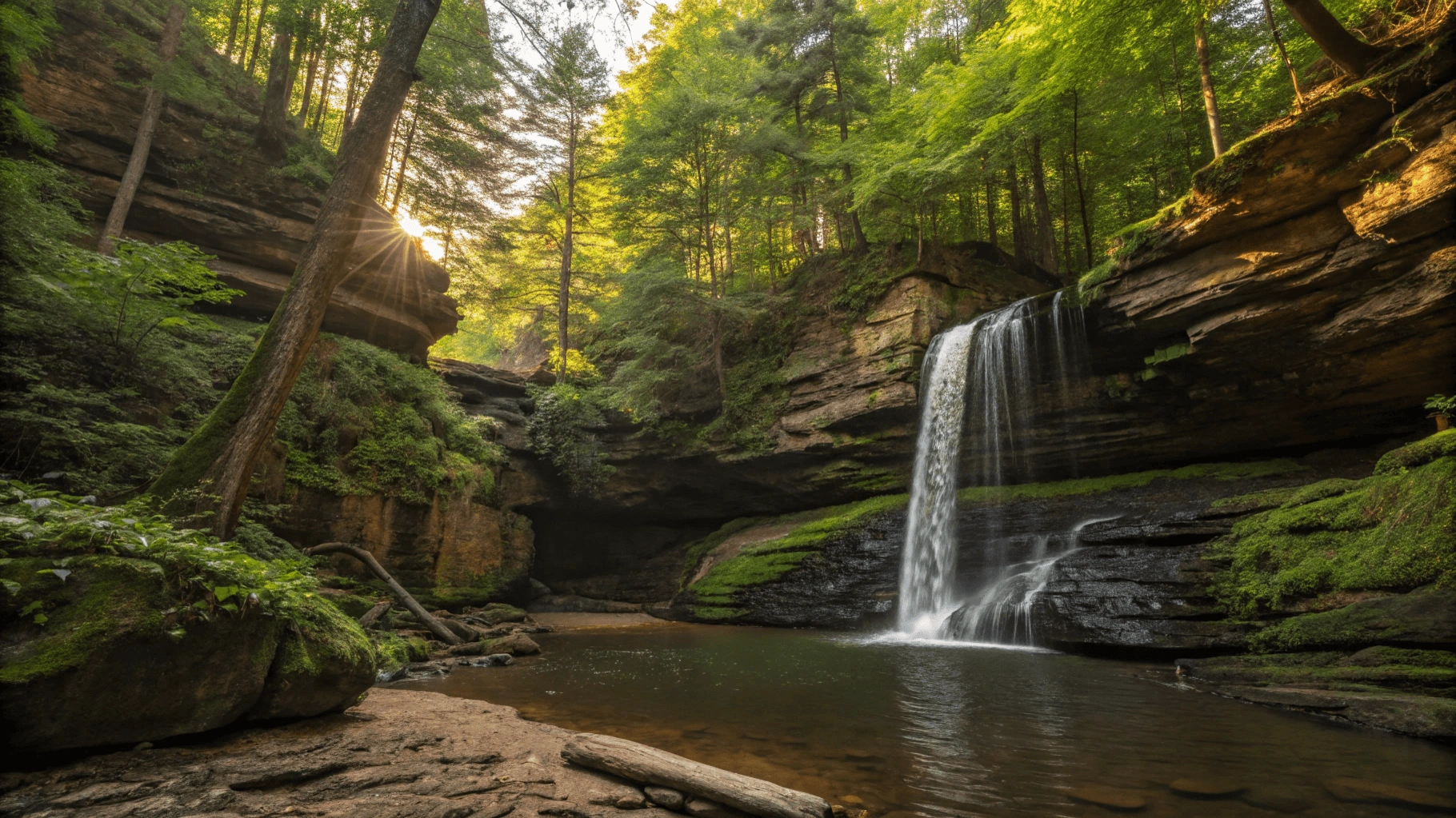Introduction
Cascading down 25 feet of ancient Black Hand Sandstone, Honey Run Waterfall creates one of central Ohio’s most mesmerizing natural spectacles. Tucked away in a serene gorge in Knox County, this hidden gem offers visitors a perfect blend of accessibility and natural beauty that rivals Ohio’s more famous outdoor destinations.
Based on multiple seasonal visits and extensive research, I’ve created this comprehensive guide to Honey Run Waterfall to help you plan the perfect visit. Whether you’re an avid hiker, a photography enthusiast, or simply looking for a peaceful nature escape, this guide covers everything you need to know about experiencing one of Ohio’s most beautiful waterfalls.
Table of Contents
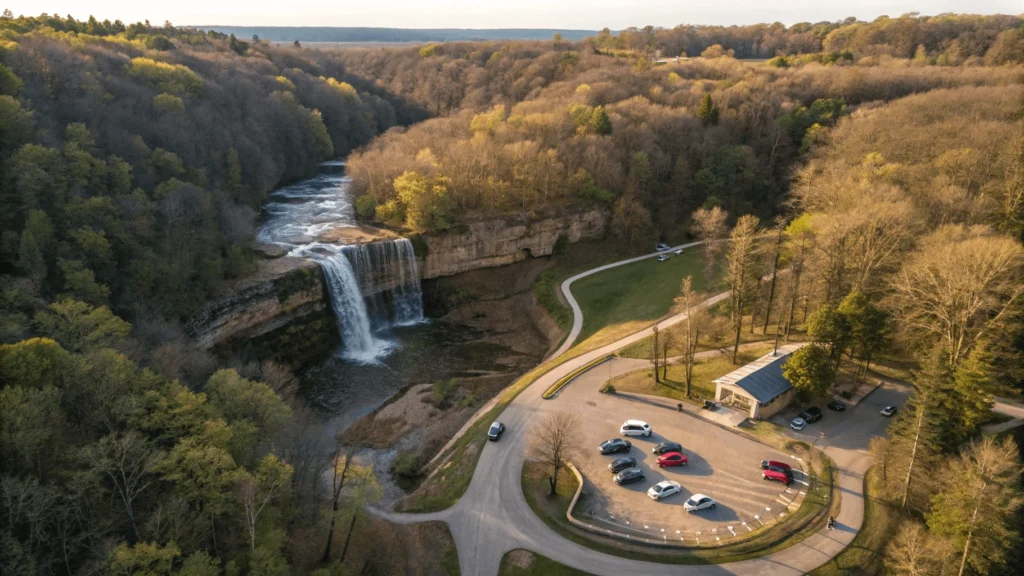
Quick Facts About Honey Run Waterfall
| Information | Details |
|---|---|
| Location | 10855 Hazel Dell Road, Howard, OH 43028 |
| GPS Coordinates | 40.4126° N, 82.3124° W |
| Park Authority | Knox County Park District |
| Hours | Dawn to Dusk, Daily |
| Entrance Fee | None (Free admission) |
| Main Trail | Honey Run Falls Trail |
| Trail Difficulty | Easy to Moderate (some stairs and uneven terrain) |
| Trail Length | 0.9 miles (loop trail) |
| Dog-Friendly | Yes, must be leashed |
| Key Features | 25-foot main waterfall, smaller cascades, sandstone cliffs, hemlock forest, Kokosing River access |
| Best Time to Visit | Spring (high water flow), Fall (stunning foliage) |
Why Visit Honey Run Waterfall?
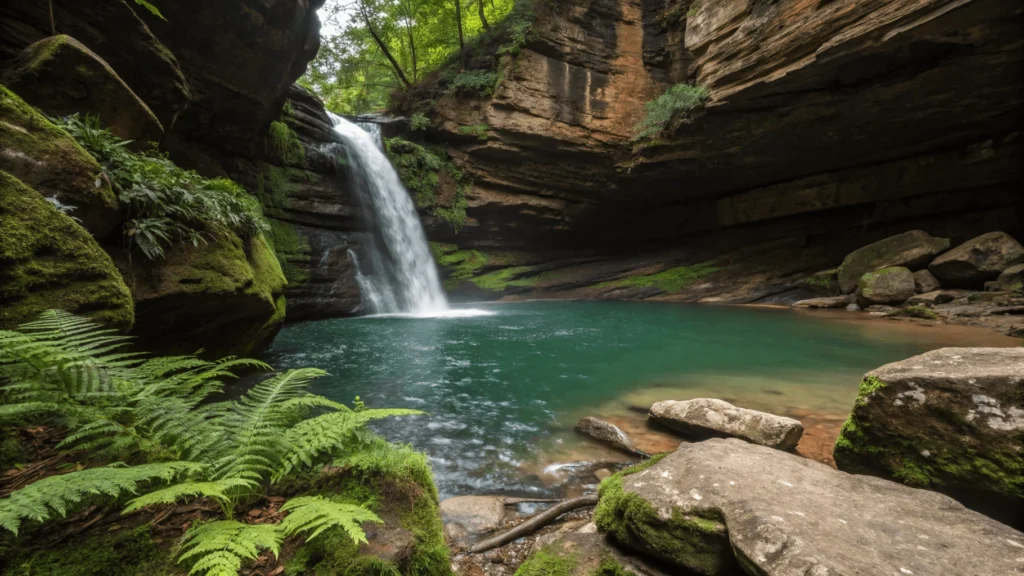
Honey Run Waterfall stands as one of central Ohio’s most captivating natural attractions, offering visitors a perfect blend of scenic beauty and accessibility that’s rare to find in the region. Unlike the often-crowded Hocking Hills destinations, Honey Run provides a more intimate connection with nature while requiring less hiking expertise.
The waterfall’s main plunge creates a spectacular 25-foot curtain of water that cascades over a rugged face of Black Hand Sandstone, creating mesmerizing patterns as it tumbles into a clear pool below. Surrounding the falls, a lush hemlock forest creates a cool microclimate even on warm summer days, making it a refreshing retreat during Ohio’s humid months.
What truly sets Honey Run apart is its diverse ecosystem packed into a relatively small area. Within just one short hike, visitors can experience:
- The dramatic main waterfall plunge
- Several smaller cascades along the creek
- Towering sandstone cliffs with unique erosion patterns
- Ancient hemlocks and diverse hardwood forests
- Rich displays of seasonal wildflowers
- Access to the scenic Kokosing River
For photographers, nature enthusiasts, families, or anyone seeking a quick nature escape, Honey Run Waterfall delivers an outsized experience that makes it well worth the visit.
Getting There & Parking
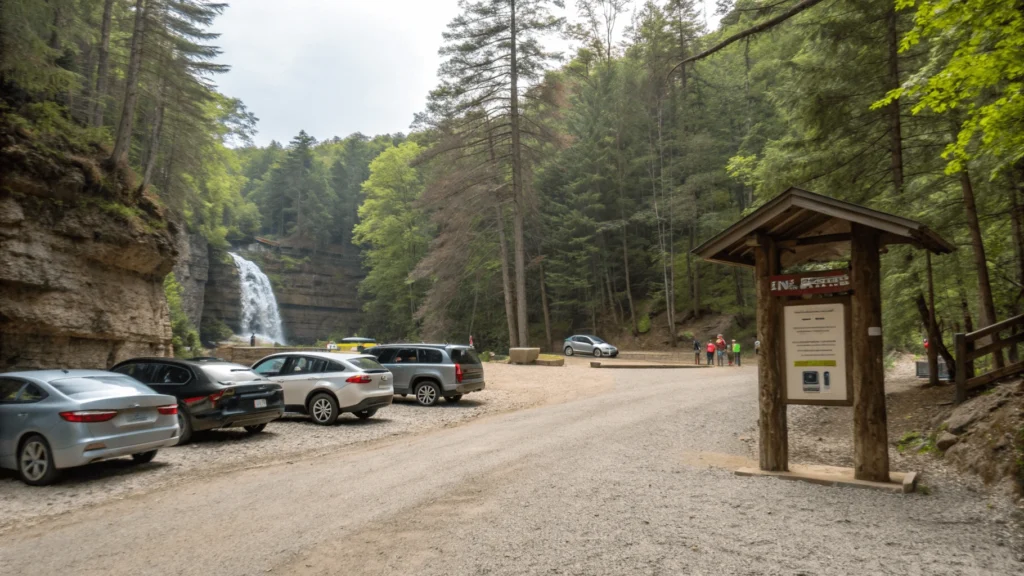
Detailed Directions
Honey Run Waterfall is conveniently located in Knox County, about an hour’s drive northeast of Columbus. Here’s how to reach it from nearby cities:
From Columbus (approximately 60 minutes):
- Take I-71 North to OH-13 North toward Mansfield
- Follow OH-13 to Mount Vernon
- In Mount Vernon, take OH-229 East
- Turn left onto Hazel Dell Road
- The parking area will be on your right after about 2 miles
From Mount Vernon (approximately 15 minutes):
- Take OH-229 East from downtown
- Turn left onto Hazel Dell Road
- Continue for approximately 2 miles to the parking area on your right
From Gambier (approximately 10 minutes):
- Head west on OH-229
- Turn right onto Hazel Dell Road
- Continue for approximately 2 miles to the parking area
Parking Information
The main parking lot at Honey Run Waterfall is a medium-sized gravel lot that accommodates approximately 25-30 vehicles. Important parking notes:
- Surface: Compacted gravel, generally accessible for most vehicles
- Size: Approximately 25-30 spaces
- Busy Times: The lot typically fills by 10 AM on summer and fall weekends
- Overflow Options: There is no designated overflow parking; when full, visitors must return later
- Accessibility: No specifically designated accessible parking spaces
Pro Tip: Arrive before 9 AM on weekends or holidays to guarantee a parking spot, especially during peak fall foliage season (mid-October) or after heavy rains when the waterfall is most impressive.
The Honey Run Falls Trail: A Step-by-Step Guide
The Honey Run Falls Trail offers a rewarding experience that’s accessible to most hikers while still providing a genuine connection with nature. Here’s a detailed breakdown of what to expect along the trail:
Trail Overview
- Total Length: 0.9 miles (loop)
- Elevation Change: Approximately 120 feet
- Average Time: 45-60 minutes (casual pace), 30 minutes (fast pace)
- Terrain: Mix of packed earth, wooden boardwalks, stone steps, and natural rock surfaces
- Difficulty: Easy to moderate, with some stairs and potentially slippery sections
Section-by-Section Trail Guide

1. Trailhead to Stairs (0.1 miles)
From the parking area, you’ll find clear signage directing you to the trailhead. The path begins as a well-maintained dirt trail that gradually descends through a mixed hardwood forest. This section is relatively flat and wide, making it accessible for most visitors.
- Terrain: Packed earth with some small roots
- Features: Interpretive signs about local ecology
- Time: Approximately 5 minutes
Note: Listen for the sound of falling water as you approach the stairs—it grows increasingly audible as you get closer to the falls.
2. The Stairs (0.1 miles)
One of the more challenging sections of the trail involves descending approximately 75 wooden stairs that take you down into the gorge. The staircase is well-built with handrails, though some steps may be uneven.
- Terrain: Wooden stairs with railings
- Challenge: Moderate (requires basic mobility)
- Time: Approximately 5-7 minutes
- Caution: Steps can be slippery when wet or icy
3. Path to the Main Falls (0.2 miles)
After descending the stairs, the trail follows Honey Run Creek upstream. This section alternates between packed earth path and wooden boardwalks that keep you above wet areas. You’ll pass several small cascades before reaching the main falls.
- Terrain: Boardwalks and packed earth
- Features: Several small cascades, hemlock groves
- Time: Approximately 10 minutes
- Wildflowers: Look for Virginia bluebells and trillium in spring
4. Main Waterfall Area (0.1 miles)
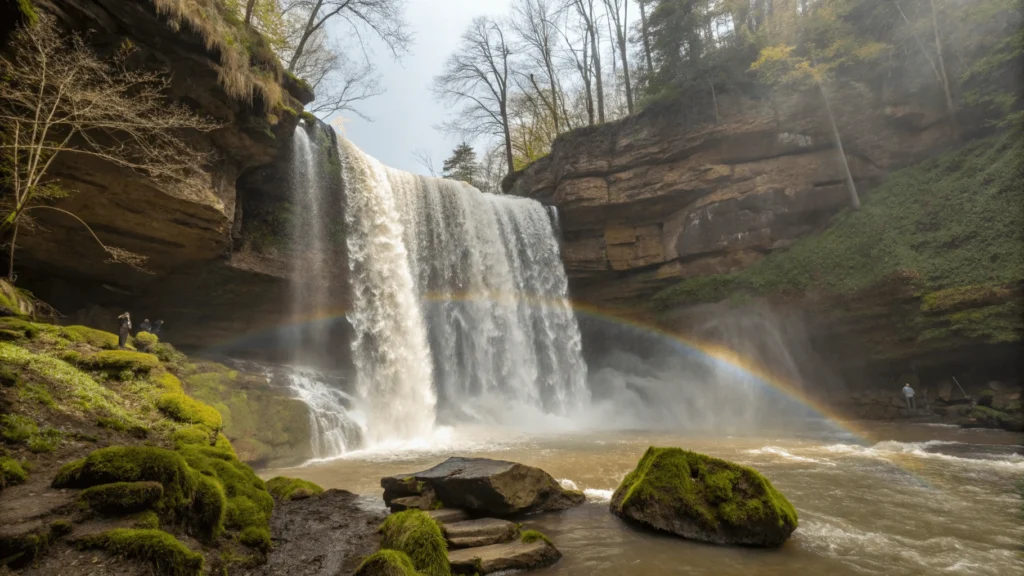
The trail opens to the main attraction—the 25-foot Honey Run Waterfall. A viewing area with several natural rock ledges allows visitors to appreciate the falls from different angles.
- Best Viewing Spots:
- Middle platform for full frontal views
- Upper rocks for top-down perspective
- Lower pool area for looking up at the falls (use caution—rocks are slippery)
- Photography: Morning light (before 11 AM) provides the best illumination
- Features: Main 25-foot waterfall, plunge pool, exposed sandstone cliffs
- Caution: NEVER climb on wet rocks near the waterfall
5. Beyond the Falls – Completing the Loop (0.4 miles)
After enjoying the main falls, continue along the trail as it loops back to the parking area. This section climbs gradually out of the gorge, offering views of the Kokosing River valley before returning to the trailhead.
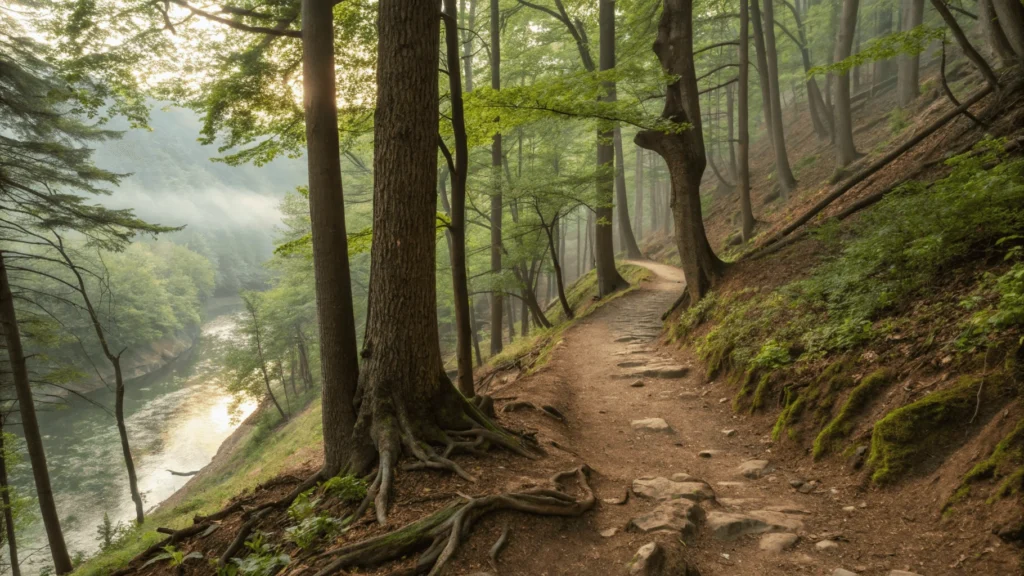
- Terrain: Natural path with some rocks and roots, moderate uphill sections
- Features: Kokosing River views, diverse forest, sandstone outcroppings
- Time: Approximately 20 minutes
- Wildlife: Watch for pileated woodpeckers, barred owls, and white-tailed deer
Accessibility Notes
While Honey Run Falls is one of the more accessible natural areas in Knox County, it does present challenges for those with mobility limitations:
- The wooden staircase (approximately 75 steps) is the primary obstacle
- No ADA-compliant paths or facilities
- Uneven terrain throughout the trail
- No wheelchair or stroller accessibility to the main waterfall
For visitors with minor mobility challenges, trekking poles can be helpful for navigating the stairs and uneven terrain.
The Waterfall Itself: Viewing & Photography
Detailed Description
Honey Run Waterfall is classified as a plunge waterfall, with water dropping approximately 25 feet from a protruding ledge of Black Hand Sandstone. The falls create a dramatic curtain effect, especially after heavy rains when water volume increases significantly.
Key characteristics:
- Height: 25 feet (main plunge)
- Type: Plunge waterfall with single drop
- Width: Varies from 5-15 feet depending on water flow
- Geology: Black Hand Sandstone formation (350 million years old)
- Water Source: Honey Run Creek, a tributary of the Kokosing River
Seasonal Changes at the Falls
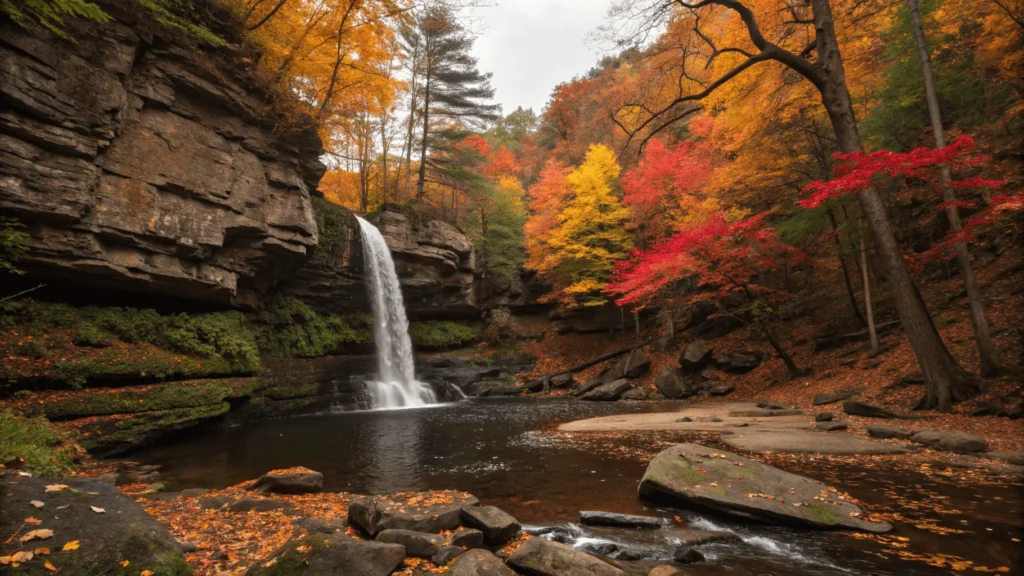
The waterfall’s appearance changes dramatically throughout the year, making repeat visits worthwhile:
| Season | Water Flow | Surroundings | Special Features |
|---|---|---|---|
| Spring | Highest flow, often full width | Lush green vegetation, wildflowers | Vibrant water action, mist, ideal photography |
| Summer | Moderate to low flow | Dense forest canopy, cool microclimate | Refreshing retreat, clear water for details |
| Fall | Variable flow depending on rainfall | Spectacular red, orange, and yellow foliage | Picture-perfect combination of falls and autumn colors |
| Winter | Low to moderate flow | Possible ice formations | Frozen columns, icicles, and ice-crusted rocks |
Photography Tips
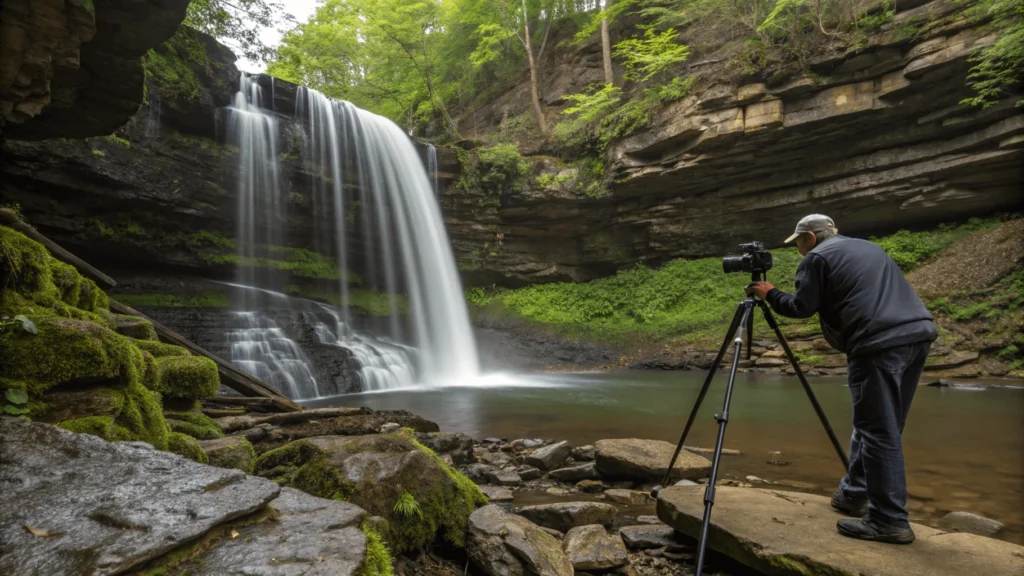
Honey Run Waterfall offers exceptional photography opportunities throughout the year:
- Best Light: Early morning (8-10 AM) when soft light filters through the trees
- Avoiding Harsh Contrasts: Cloudy days provide ideal diffused lighting
- Water Flow: Check rainfall reports—2-3 days after heavy rain offers optimal flow
- Equipment Recommendations:
- Tripod essential for long exposures
- Polarizing filter to reduce glare on wet surfaces
- Wide-angle lens (16-35mm) for capturing the entire scene
- Neutral density filter for silky water effects in daylight
- Composition Ideas:
- Frame the falls with overhanging hemlock branches
- Include foreground rocks for depth
- Capture reflections in the plunge pool
- Try vertical orientation to emphasize the height of the falls
Photography Tip: For silky water effects, use a tripod with shutter speeds between 1/15 and 1 second. The ideal exposure varies with light conditions, but start with f/16, ISO 100, and adjust shutter speed accordingly.
Flora, Fauna & Geology
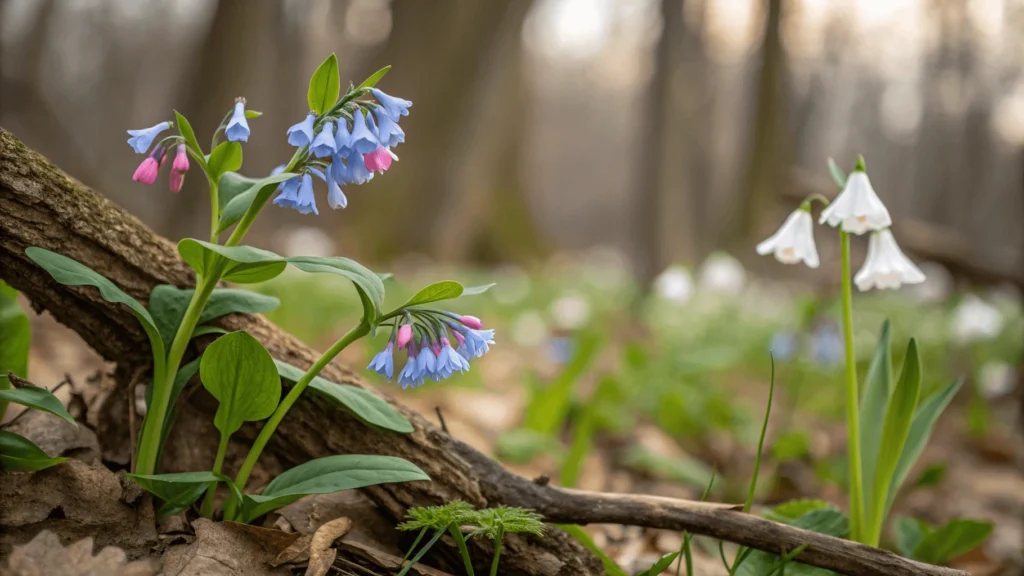
Plant Life at Honey Run
The Honey Run Falls area hosts a diverse collection of plant life thanks to its unique microclimate. The deep gorge created by Honey Run Creek maintains higher humidity and cooler temperatures than surrounding areas, supporting plant species typically found further north.
Notable Trees:
- Eastern Hemlock (dominant in the gorge)
- Yellow Birch
- American Beech
- Sugar Maple
- Tulip Poplar
Wildflowers (seasonal):
- Spring: Virginia Bluebells, Trillium, Jack-in-the-Pulpit, Wild Geranium
- Summer: Jewelweed, Black-Eyed Susan, Wild Bergamot
- Fall: Goldenrod, Asters, Cardinal Flower
Naturalist Note: The Eastern Hemlock trees found throughout the gorge are remnants from the last ice age, when cooler climates dominated Ohio. These ancient trees have persisted in the cool microclimate of the gorge.
Wildlife Spotting
While wildlife tends to avoid heavily trafficked areas of the trail, patient and observant visitors may encounter:
Common Birds:
- Pileated Woodpecker
- Barred Owl
- Louisiana Waterthrush
- Black-throated Green Warbler
- Wood Thrush
Mammals:
- White-tailed Deer
- Eastern Chipmunk
- Gray Squirrel
- Occasionally: Red Fox, Raccoon
Amphibians (near water):
- Northern Dusky Salamander
- Two-lined Salamander
- Spring Peeper
Fascinating Geology
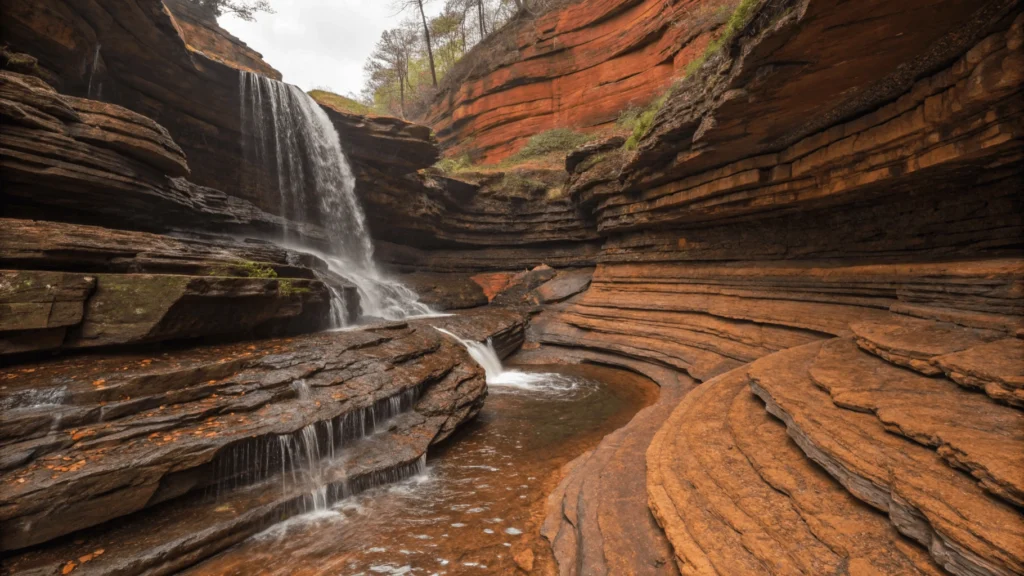
The distinctive Black Hand Sandstone formation that creates Honey Run Waterfall tells a geological story dating back approximately 350 million years:
- Formation Period: Mississippian Period (350-320 million years ago)
- Origin: Ancient river delta deposits
- Composition: Primarily quartz sand with iron oxide (giving it reddish hues)
- Characteristics: Coarse-grained, cross-bedded, resistant to erosion
- Process: The waterfall forms where Honey Run Creek flows over an especially resistant layer of this sandstone
The differential erosion process continues today—softer rock layers underneath erode faster, creating the overhanging ledge that allows the water to “plunge” rather than cascade down a slope.
Best Times to Visit
By Season
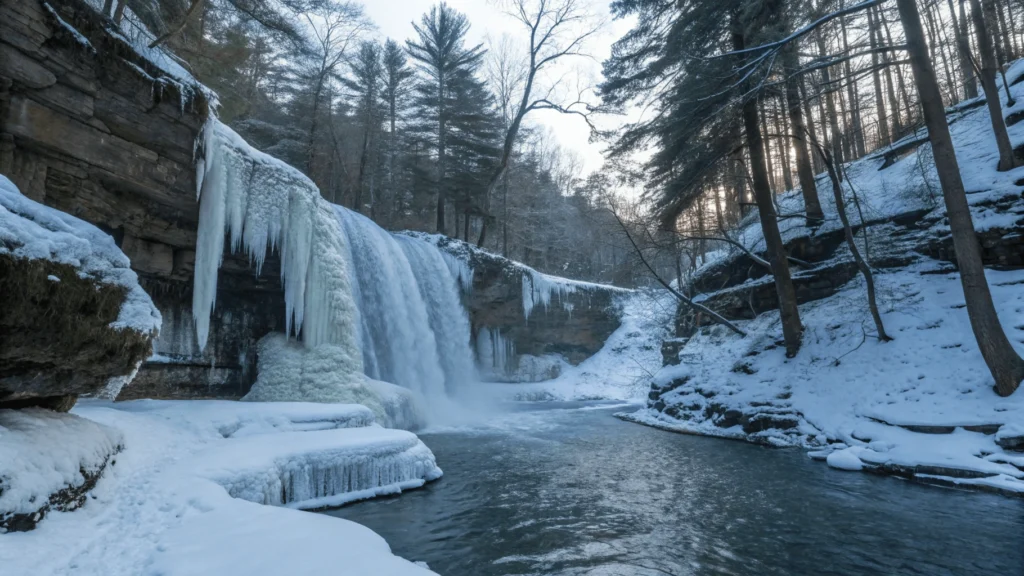
Each season offers a unique experience at Honey Run Waterfall:
Spring (March-May)
- Pros: Peak water flow, emerging wildflowers, comfortable temperatures
- Cons: Potential for muddy trails, occasional flooding after heavy rain
- Highlight: Mid-April brings the best combination of strong water flow and wildflower displays
Summer (June-August)
- Pros: Lush green surroundings, cooler temperatures in the gorge
- Cons: Lower water flow during dry periods, more crowded on weekends
- Highlight: Early mornings offer peaceful experiences with filtered light through the forest canopy
Fall (September-November)
- Pros: Spectacular foliage, moderate water flow, comfortable hiking weather
- Cons: Extremely busy on peak foliage weekends
- Highlight: Mid-October typically offers the best fall colors around the waterfall
Winter (December-February)
- Pros: Possible ice formations, solitude, unique photo opportunities
- Cons: Potentially dangerous slippery conditions, cold temperatures
- Highlight: After several days of below-freezing temperatures, impressive ice formations develop around the falls
By Day & Time
Weekdays vs. Weekends:
- Weekdays offer significantly fewer visitors, especially Monday through Thursday
- Weekend visitation peaks between 11 AM and 3 PM
- Sunday mornings before 10 AM often provide a good balance of decent light and smaller crowds
Time of Day:
- Early morning (7-9 AM): Best light for photography, fewest visitors
- Midday (11 AM-2 PM): Brightest conditions but harsh lighting and most crowded
- Late afternoon (4-6 PM): More subdued lighting, moderate crowds
Insider Tip: The absolute best time to visit Honey Run Waterfall is on a weekday morning, 2-3 days after significant rainfall, during mid-spring or early fall. This combination provides optimal water flow, good lighting, minimal crowds, and comfortable temperatures.
Essential Visitor Tips & What to Bring
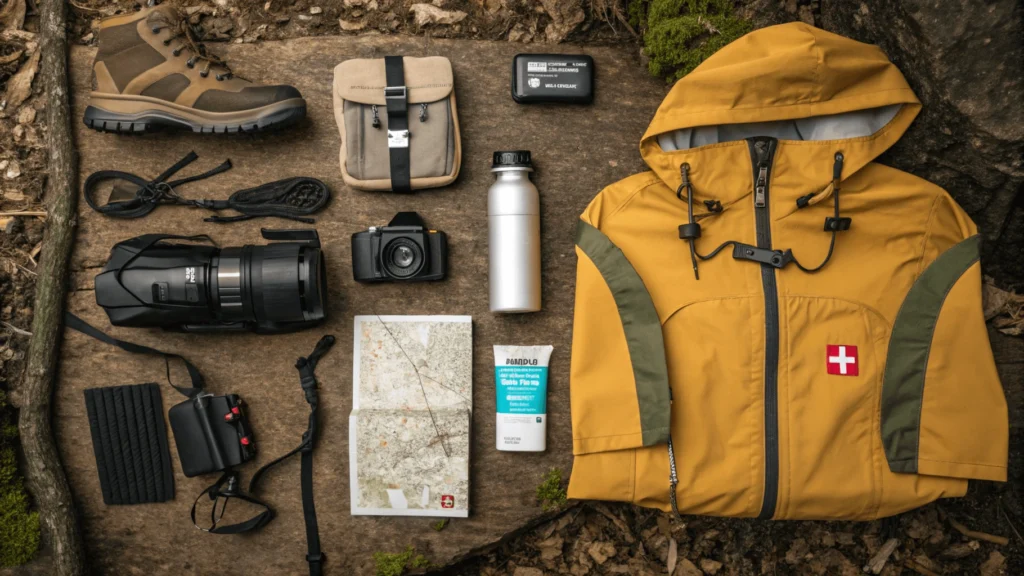
Packing Essentials
| Item | Season | Notes |
|---|---|---|
| Footwear | All Seasons | Waterproof hiking boots or trail runners with good traction |
| Water | All Seasons | At least 1 liter per person (no water sources at the park) |
| Snacks | All Seasons | Energy bars or trail mix recommended |
| Insect Repellent | Spring-Fall | Especially important May-September |
| Sunscreen | Spring-Fall | Even with forest cover, protection is advisable |
| Camera | All Seasons | Don’t forget extra batteries and memory cards |
| Trekking Poles | Optional | Helpful for stability on stairs and uneven terrain |
| First Aid Kit | All Seasons | Basic kit with bandages, antiseptic wipes |
| Rain Gear | All Seasons | Weather can change quickly |
| Extra Layers | All Seasons | The gorge can be 10°F cooler than surrounding areas |
Trail Etiquette & Safety Tips
- Stay on designated trails to prevent erosion and protect delicate plant life
- Never climb on wet rocks near the waterfall—they’re extremely slippery
- Pack out all trash—there are no garbage cans along the trail
- Keep dogs leashed at all times and clean up after them
- Maintain appropriate noise levels to respect wildlife and other visitors
- Check weather forecasts before visiting—flash flooding can occur after heavy rain
- Let someone know your hiking plans if visiting during off-peak times
- Bring a fully charged phone for emergencies (cell service is limited but present)
- Wear appropriate footwear—flip-flops or dress shoes are dangerous on the trail
- Respect closure times—the park closes at dusk
Safety Warning: Never attempt to climb the waterfall face or swim in the plunge pool. Both activities are prohibited and extremely dangerous.
Park Rules & Regulations
The Knox County Park District maintains Honey Run Waterfall as a natural preserve with specific regulations to ensure visitor safety and environmental protection:
- Hours: Open daily from dawn to dusk
- Dogs: Allowed on leash only (maximum 6-foot leash)
- Swimming: Prohibited in all water areas
- Climbing: Not permitted on waterfall or cliff faces
- Collecting: No removal of plants, rocks, wildlife, or other natural materials
- Alcohol: Prohibited throughout the park
- Drones: Not permitted without special permit
- Camping: Not allowed
- Fires: Prohibited
- Bicycles: Not permitted on trails
For the most current and comprehensive rules, please visit the official Knox County Parks website.
Dog-Friendliness Confirmed
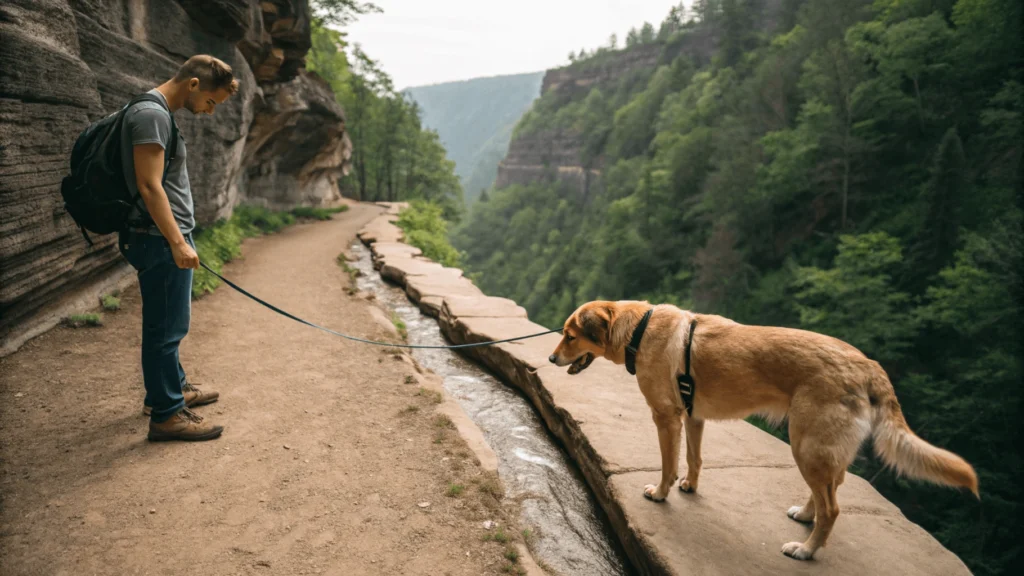
Good news for dog owners—Honey Run Waterfall is indeed dog-friendly! Here’s what you need to know about bringing your four-legged companion:
- Dogs must remain on leash (maximum 6-foot leash) at all times
- Owners must clean up after their pets (bring your own waste bags)
- Water access is limited, so bring drinking water for your dog
- The wooden stairs may be challenging for some older or smaller dogs
- Consider booties for your dog if visiting in winter (salt is not used on trails, but ice can be rough on paws)
Nearby Attractions & Making a Day Trip
Honey Run Waterfall is surrounded by other impressive attractions that make Knox County worth a full day of exploration. Here’s how to expand your visit:
Other Knox County Parks (10-20 minute drives)
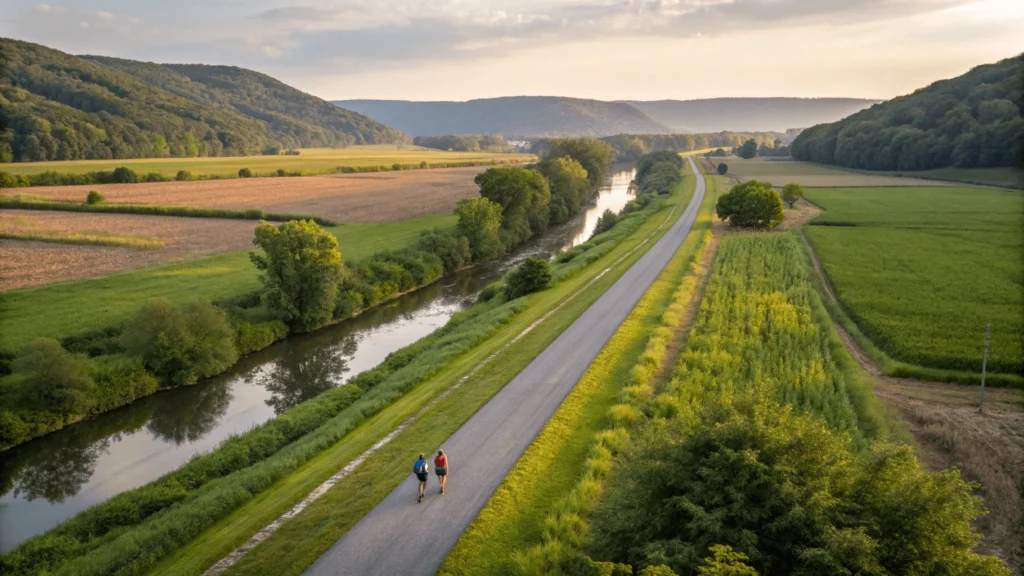
Wolf Run Regional Park (15 minutes from Honey Run)
- 295 acres with nearly 5 miles of hiking trails
- Mountain biking trails
- Fishing pond
- Picnic areas and shelter house
Mohican Valley Trail (20 minutes from Honey Run)
- 4.5-mile converted rail trail
- Bridge of Dreams (covered bridge)
- Excellent for biking and walking
- Connects to Kokosing Gap Trail
Gambier & Kenyon College (15 minutes from Honey Run)
- Scenic college campus with Gothic architecture
- Brown Family Environmental Center (trails and gardens)
- Village Market for lunch supplies
- Kenyon Bookstore
Mount Vernon (15 minutes from Honey Run)
Ariel-Foundation Park (former industrial site transformed)
- Unique industrial ruins
- Walking paths
- Lakes and observation tower
Downtown Mount Vernon
- Local dining options:
- The Joint (casual American)
- North Main Café (breakfast/lunch)
- Stein Brewing Company (craft beer and pub food)
- Shopping on Main Street
- Historic architecture
Kokosing Gap Trail (10 minutes from Honey Run)
- 14-mile paved rail-trail
- Follows the scenic Kokosing River
- Historic train display in Gambier
- Perfect for biking, walking, or running
Suggested Day Trip Itinerary
Morning:
- 8:00 AM: Arrive at Honey Run Waterfall
- 8:00-10:00 AM: Explore the falls and complete the loop trail
- 10:30 AM: Visit Wolf Run Regional Park for additional hiking
Midday:
- 12:30 PM: Lunch in Mount Vernon (North Main Café recommended)
- 1:30 PM: Explore Ariel-Foundation Park
Afternoon:
- 3:00 PM: Rent bikes in Gambier and ride a portion of the Kokosing Gap Trail
- 5:00 PM: Dinner at Stein Brewing Company in Mount Vernon
Brief History of Honey Run Waterfall
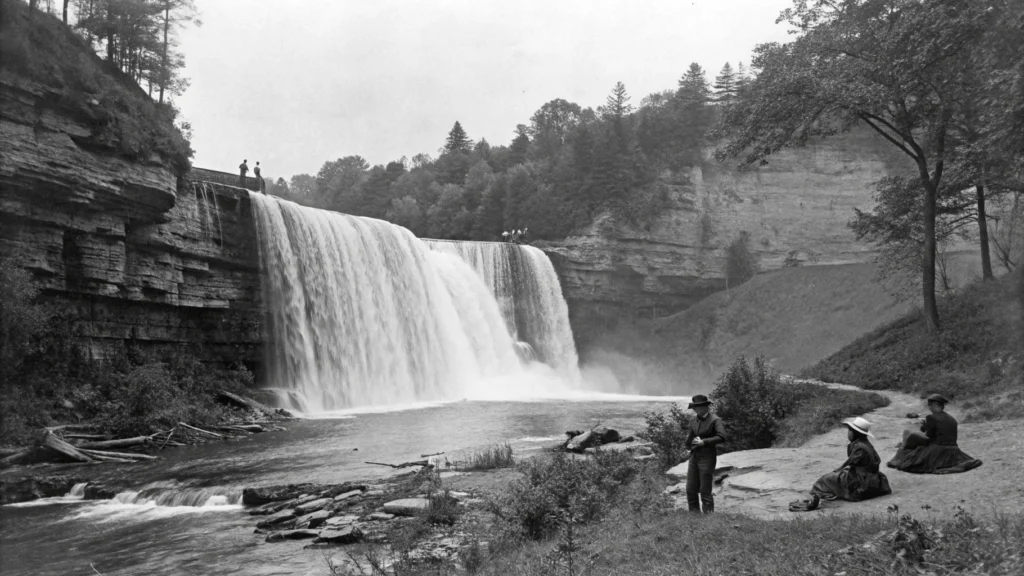
Honey Run Waterfall has a fascinating history that adds depth to your visit:
In the early 1900s, the area around Honey Run was primarily farmland, but the steep gorge remained largely untouched due to its unsuitability for agriculture. Local residents had long known about the “hidden waterfall” and would often visit for recreation and picnics.
In 1964, concerned about potential private development threatening the area, a group of local conservationists began efforts to protect the gorge and waterfall. Their persistence paid off in 1980 when the Knox County Park District was formed and acquired the initial 44 acres surrounding Honey Run Waterfall.
Over the following decades, additional land purchases expanded the preserve to its current size. In 1998, the wooden staircase and initial trail system were constructed to provide safer access while protecting the fragile ecosystem.
Today, the Honey Run Highlands area encompasses over 400 acres of protected land, ensuring that this natural treasure remains accessible for generations to come.
Frequently Asked Questions
Is Honey Run Waterfall difficult to hike?
Honey Run Waterfall trail is considered easy to moderate. Most visitors can complete the main loop trail without difficulty, though there are approximately 75 wooden stairs and some uneven terrain. The total loop is less than a mile, making it accessible for most casual hikers.
Can you swim at Honey Run Falls?
No, swimming is strictly prohibited at Honey Run Waterfall. The water depth is unpredictable, underwater obstacles exist, and the rocks are extremely slippery. Additionally, swimming would damage the fragile ecosystem of the plunge pool.
Is Honey Run Waterfall good for kids?
Yes, Honey Run Waterfall is suitable for children who can navigate stairs independently. The short trail length makes it family-friendly, though parents should keep young children close, especially near the waterfall and creek. The various natural features provide excellent educational opportunities.
Are there restrooms at Honey Run Waterfall?
No, there are no restroom facilities at Honey Run Waterfall. The nearest public restrooms are located in Mount Vernon or Gambier, approximately 15 minutes away by car. Plan accordingly before your visit.
How long does it take to hike Honey Run Falls?
Most visitors spend 45-60 minutes completing the entire loop trail at a casual pace. Photography enthusiasts typically spend 1-2 hours to fully appreciate and capture the waterfall from various angles. The absolute minimum time needed is about 30 minutes if walking at a brisk pace.
Is Honey Run Waterfall free?
Yes, admission to Honey Run Waterfall is completely free. The Knox County Park District maintains the area through tax support and donations, allowing visitors to enjoy this natural wonder without entrance fees.
When is water flow best at Honey Run Waterfall?
No, drone usage is prohibited in Knox County Parks without special permission. This restriction protects wildlife, preserves the natural soundscape, and ensures privacy and safety for all visitors.
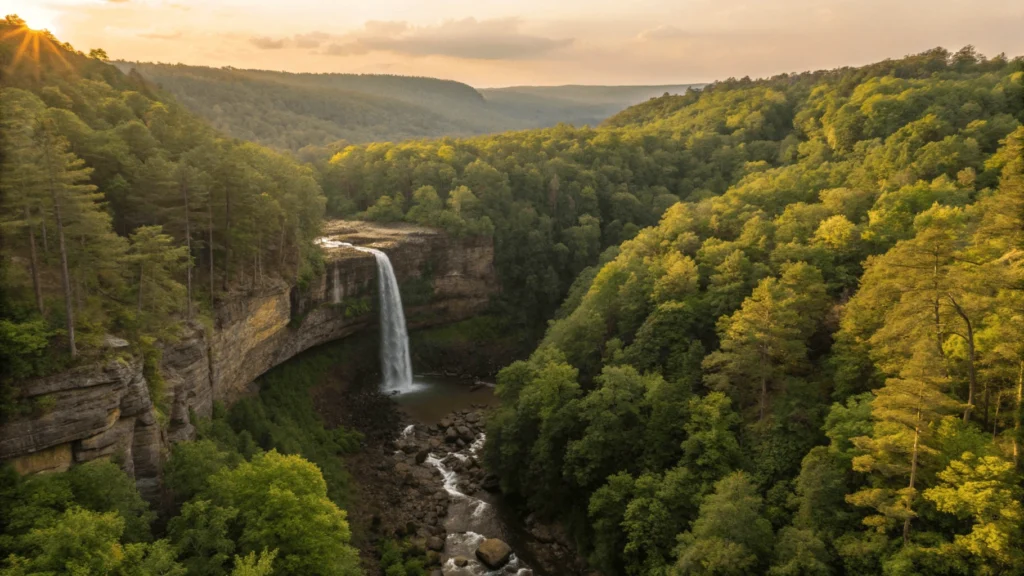
Conclusion
Honey Run Waterfall stands as one of central Ohio’s true hidden gems—a perfect blend of natural beauty, accessibility, and ecological diversity packed into a compact area. Whether you’re capturing the perfect waterfall photograph, enjoying a short family hike, or simply seeking a peaceful moment in nature, this Knox County treasure delivers an experience that rivals more famous Ohio destinations.
The changing seasons ensure that no two visits are ever quite the same, from the rushing spring waters and wildflower displays to the breathtaking autumn colors reflecting in the falls. By following the guidelines in this guide, you’ll be well-prepared to make the most of your visit while helping preserve this special place for future generations.
Have you visited Honey Run Waterfall? Share your experiences and tips in the comments below! And if this guide helped you plan your trip, consider sharing it with fellow nature lovers who might enjoy discovering this central Ohio wonder.
Last Updated: April 2025

